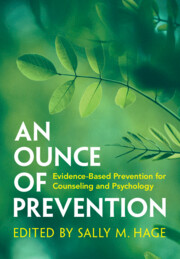Book contents
- An Ounce of Prevention
- An Ounce of Prevention
- Copyright page
- Dedication
- Contents
- Figures
- Contributors
- Acknowledgments
- Part One A Foundation in Prevention
- Part Two Prevention with Children and Youth
- Part Three Prevention with Emerging Adults
- 8 Ecological and Developmental Approaches to Reducing Substance Use and Related Harms among Emerging Adults
- 9 Building Action from Awareness Movements
- 10 Best Practices in Building Comprehensive Strategies to Prevent Sexual Violence for College-Age Students
- 11 College: The Window of Opportunity
- Part Four Across the Lifespan: Adults and Families
- Part Five Closing
- Index
- References
10 - Best Practices in Building Comprehensive Strategies to Prevent Sexual Violence for College-Age Students
from Part Three - Prevention with Emerging Adults
Published online by Cambridge University Press: 14 November 2024
- An Ounce of Prevention
- An Ounce of Prevention
- Copyright page
- Dedication
- Contents
- Figures
- Contributors
- Acknowledgments
- Part One A Foundation in Prevention
- Part Two Prevention with Children and Youth
- Part Three Prevention with Emerging Adults
- 8 Ecological and Developmental Approaches to Reducing Substance Use and Related Harms among Emerging Adults
- 9 Building Action from Awareness Movements
- 10 Best Practices in Building Comprehensive Strategies to Prevent Sexual Violence for College-Age Students
- 11 College: The Window of Opportunity
- Part Four Across the Lifespan: Adults and Families
- Part Five Closing
- Index
- References
Summary
This chapter presents best practices for building comprehensive strategies to prevent sexual violence victimization and perpetration on college campuses. The chapter begins by reviewing the history of legislation that has evolved to not only support but require prevention programming on publicly funded campuses. While this legislation set the stage to ensure prevention programming on campuses, building prevention strategies that are comprehensive and inclusive is a challenge. The literature on the necessary elements making up a comprehensive strategy is presented. The remainder of the chapter reviews what the field has learned that promotes building such strategies. Using the application of the public health model (Mercy et al., 2003), the chapter discusses navigating successful team building, using data to assess campus needs, engaging in strategy selection, evaluating strategies, disseminating strategies that work, and promoting inclusive practices in the process.
- Type
- Chapter
- Information
- An Ounce of PreventionEvidence-Based Prevention for Counseling and Psychology, pp. 197 - 218Publisher: Cambridge University PressPrint publication year: 2024

